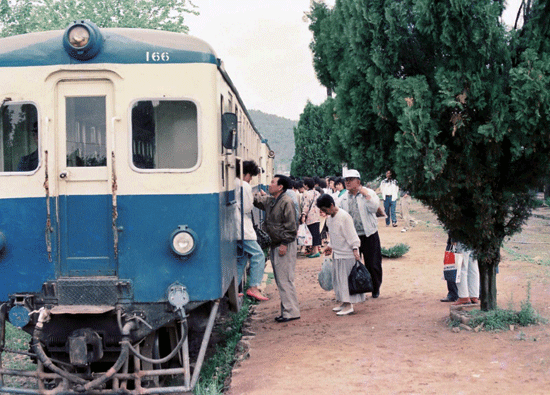Suin Line
Korail Class 351000
Before reading this section, it is recommended to read the "Brief Intro to Numbering" section on the Trains page.
Third Generation
The Suin Line uses the same Korail Class 351000 trains as the ones used on the Bundang Line. Eight third generation trains were built in 2011 for the line's opening, numbered 351x61~351x68. As the line was not open yet as the trains were delivered, trains 351x61~351x64 ran on the Jungang Line when trains there were reduced from eight to six cars.
These trains were originally delivered in a red and blue livery, the same ones used on Line 1 and the Gyeongui-Jungang Line. These have since been repainted to the same yellow and blue livery used on the Bundang Line.
All trains are six cars long. The car numbering is as follows:
3510XX-Tc (Leading car with cab, SIV, air compressor, battery)
3511XX-M (Inverter, controller and converter)
3512XX-M' (Pantograph, transformer, inverter, controller)
3513XX-T (Unpowered car)
3514XX-M'
3515XX-Tc

Train 351x61, before repaint.
By 분당선M - 자작, CC BY-SA 3.0, https://commons.wikimedia.org/w/index.php?curid=20169603
An additional four trains, numbered 351x69~351x72, were built in 2013 to address the opening of Phase 2. These trains were delivered with LED headlights.
These trains also initially wore the red and blue livery, but they have since been repainted.
These trains temporarily ran on the Bundang Line in 2014 when trains 351x34~351x40 were out of service.
.jpg)
Fourth Generation
The fourth generation of trains were built in 2017. Two trains were built for the Suin Line, 351x77 and 351x78.
These trains share the small improvements brought on by the 삼눈이 design: a third driving light, single-arm pantographs, and CCTV cameras.
These trains were delivered with the yellow and blue livery.
.jpg)
All trains are currently stored at Line 4's Siheung Depot.
Nageha-type Gasoline Car
The Nageha-type cars were built starting in 1928 by Nippon-Sharyo. The initial batch built from 1928 to 1929 produced seven units, classified Type 1. Originally built for the Donghae Jungbu Line (which was divided into the present-day Daegu, Jungang and Donghae Lines), these were soon transferred to Suin Line service.
The Type 1s were powered by a Ford automobile engine producing 33 horsepower. The driving performance was similar to cars at that time. The five cars produced in 1928 used a 6V generator and storage battery, while the two built in 1929 used a 24V axle generator. Maximum capacity was 30 passengers.

None of these cars were preserved and there are no photos of these cars on the internet. Here is a similar Kiha Type 2 car preserved in Japan.
By 100yen - 자작, CC BY-SA 3.0, https://commons.wikimedia.org/w/index.php?curid=4892872
The Railway Bureau decided that the car type was optimal for city driving, so similar cars were produced starting in 1930, designated Type 2. Four cars were built in 1930 and two in 1931. In total, 13 cars were built.
Compared to the Type 1s, and Type 2s had a more powerful 62 horsepower engine. The overall dimensions were also increased, allowing the Type 2s to hold 45 passengers.
All cars were retired and scrapped in the 1960s with the introduction of the narrow-gauge diesel cars.
Hyeogi-type Steam Locomotive
The Hyeogi-type narrow-gauge locomotives were built starting in 1927 for the Suin and Suryeo Lines. It is not known when production ended, or the exact number of locomotives built.
The design is a typical tender steam locomotive common at that time.

Type 11-13 preserved at the Korail Railroad Museum in Uiwang.
By 조사부장 from kowp - ko:file:Korea Railroad Hyeogi 11 13.jpg on kowp, CC BY-SA 3.0, https://commons.wikimedia.org/w/index.php?curid=3215476
Service frequency was slowly pulled back with the introduction of the narrow-gauge diesel cars in 1965. Eventually, all locomotives were retired in 1978.
Several locomotives were preserved:
-
Type 1 was originally preserved in Seoul Children's Grand Park, but now it resides at the original Hwarangdae Station on the Gyeongchun Line.
-
Type 7 was originally at Dambang Culture Park in Incheon, but it has since been moved to the Sorae History Museum.
-
Type 8 was originally at Heuksan Island in Jeollam-do, as a gift for Children's Day in 1978. It was sold to Hanjin Heavy Industries in 1996, and it is not known what happened to it after.
-
Type 8-28 is at the National Children's Science Museum at Jongno.
-
Type 11-12 is at the Samsung Transportation Museum in Everland.
-
Type 11-13 is at the Korail Railroad Museum. (photo above)
-
Type 11-14 is at Yongpyong Resort in Pyeongchang.
Narrow-gauge Diesel Car
The Narrow-gauge Diesel Hydraulic Cars were built in 1965 by Incheon Works. Designed to replace the aging Nageha-type cars, six cars were built, numbered 161~166. Shortly after, they were renumbered 9160~9165.
Although they were built as single cars, they could be coupled together on either end. Propulsion was a 200 horsepower Niigata diesel-hydraulic system. Maximum occupancy was 90 passengers.
Intially painted green, these cars were repainted to the blue and white Korail livery in the 1980s. They recieved the green and white livery around 1993. The propulsion systems were also replaced with newer Cummins engines.

These cars were retired with the closure of the original Suin Line in 1995. Initially, cars 9163~9165 were known to be preserved; it is unknown what exactly happened to the rest. Car 9164 was used for a local restaurant before being scrapped sometime between April 2010 and June 2011. Car 9165 was left abandoned in Goyang for a while, but was eventually seized by the city and scrapped in 2006. Its steering wheel is preserved in Incheon.
This leaves car 9163 as the only intact example known at the moment, currently at the Korail Railraod Museum.
.jpg)
Cars 9164 and 9165 on December 31, 1995, the final day of services on the original Suin Line. Footage of the day can be found here.
Back to Trains
Back to History
Back to Seoul Metro